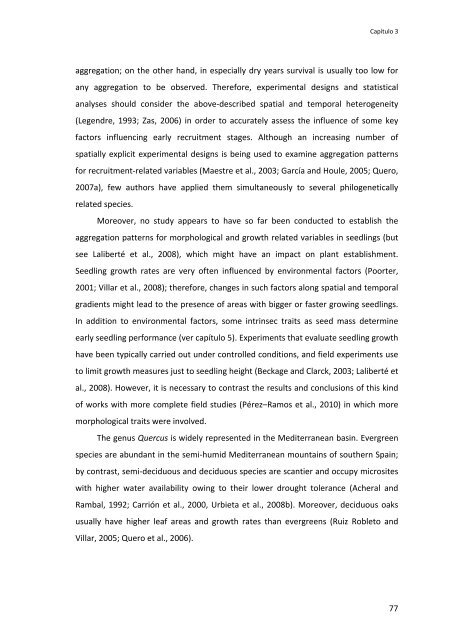Establecimiento de cuatro especies de Quercus en el sur de la ...
Establecimiento de cuatro especies de Quercus en el sur de la ...
Establecimiento de cuatro especies de Quercus en el sur de la ...
Create successful ePaper yourself
Turn your PDF publications into a flip-book with our unique Google optimized e-Paper software.
Capítulo 3<br />
aggregation; on the other hand, in especially dry years <strong>sur</strong>vival is usually too low for<br />
any aggregation to be observed. Therefore, experim<strong>en</strong>tal <strong>de</strong>signs and statistical<br />
analyses should consi<strong>de</strong>r the above‐<strong>de</strong>scribed spatial and temporal heterog<strong>en</strong>eity<br />
(Leg<strong>en</strong>dre, 1993; Zas, 2006) in or<strong>de</strong>r to accurat<strong>el</strong>y assess the influ<strong>en</strong>ce of some key<br />
factors influ<strong>en</strong>cing early recruitm<strong>en</strong>t stages. Although an increasing number of<br />
spatially explicit experim<strong>en</strong>tal <strong>de</strong>signs is being used to examine aggregation patterns<br />
for recruitm<strong>en</strong>t‐r<strong>el</strong>ated variables (Maestre et al., 2003; García and Houle, 2005; Quero,<br />
2007a), few authors have applied them simultaneously to several philog<strong>en</strong>etically<br />
r<strong>el</strong>ated species.<br />
Moreover, no study appears to have so far be<strong>en</strong> conducted to establish the<br />
aggregation patterns for morphological and growth r<strong>el</strong>ated variables in seedlings (but<br />
see Laliberté et al., 2008), which might have an impact on p<strong>la</strong>nt establishm<strong>en</strong>t.<br />
Seedling growth rates are very oft<strong>en</strong> influ<strong>en</strong>ced by <strong>en</strong>vironm<strong>en</strong>tal factors (Poorter,<br />
2001; Vil<strong>la</strong>r et al., 2008); therefore, changes in such factors along spatial and temporal<br />
gradi<strong>en</strong>ts might lead to the pres<strong>en</strong>ce of areas with bigger or faster growing seedlings.<br />
In addition to <strong>en</strong>vironm<strong>en</strong>tal factors, some intrinsec traits as seed mass <strong>de</strong>termine<br />
early seedling performance (ver capítulo 5). Experim<strong>en</strong>ts that evaluate seedling growth<br />
have be<strong>en</strong> typically carried out un<strong>de</strong>r controlled conditions, and fi<strong>el</strong>d experim<strong>en</strong>ts use<br />
to limit growth mea<strong>sur</strong>es just to seedling height (Beckage and C<strong>la</strong>rck, 2003; Laliberté et<br />
al., 2008). However, it is necessary to contrast the results and conclusions of this kind<br />
of works with more complete fi<strong>el</strong>d studies (Pérez–Ramos et al., 2010) in which more<br />
morphological traits were involved.<br />
The g<strong>en</strong>us <strong>Quercus</strong> is wi<strong>de</strong>ly repres<strong>en</strong>ted in the Mediterranean basin. Evergre<strong>en</strong><br />
species are abundant in the semi‐humid Mediterranean mountains of southern Spain;<br />
by contrast, semi‐<strong>de</strong>ciduous and <strong>de</strong>ciduous species are scantier and occupy microsites<br />
with higher water avai<strong>la</strong>bility owing to their lower drought tolerance (Acheral and<br />
Rambal, 1992; Carrión et al., 2000, Urbieta et al., 2008b). Moreover, <strong>de</strong>ciduous oaks<br />
usually have higher leaf areas and growth rates than evergre<strong>en</strong>s (Ruiz Robleto and<br />
Vil<strong>la</strong>r, 2005; Quero et al., 2006).<br />
77

















